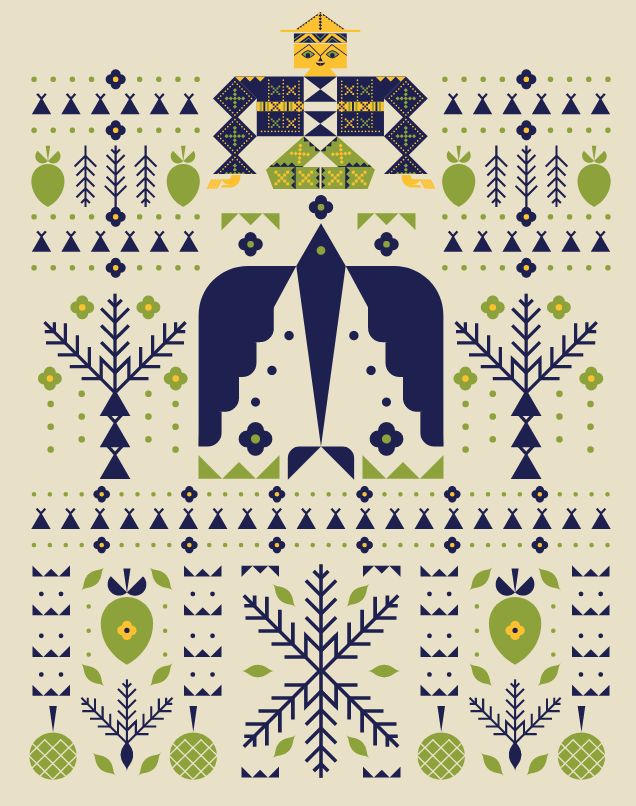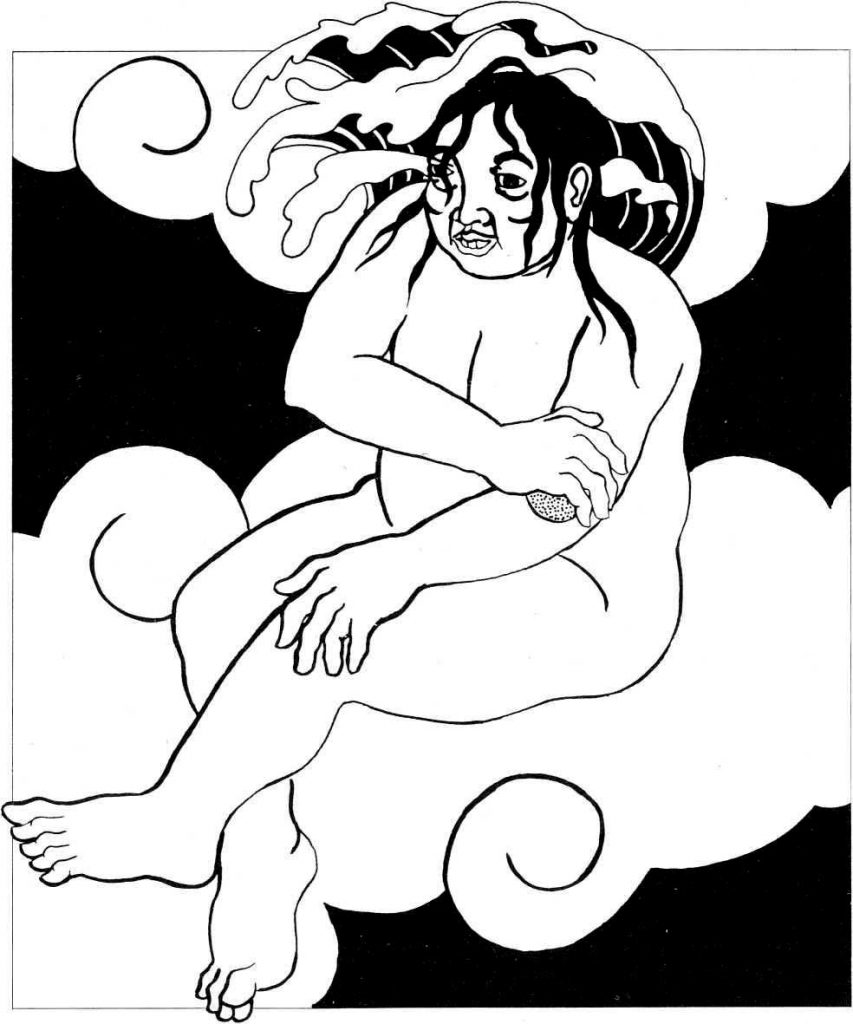The Blaan or B`laan (are an indigenous group that is concentrated in Davao del Sur and South Cotabato. They are neighbors of the Tboli, and live in Lake Sebu and Tboli municipalities of South Cotabato, Sarangani, General Santos City, the southeastern part of Davao and around Lake Buluan in North Cotabato. They are famous for their brassworks, beadwork, and tabih weave. The Blaan wear colorful embroidered native costumes and beadwork accessories. The women of these tribes, particularly, wear heavy brass belts with brass “tassels” ending in tiny brass bells that herald their approach even when they are a long way off.
THE BLAAN STORY OF CREATION: Version One
There are two main deities present in the first version of the story:
Melu: the creator deity whose teeth are pure gold and whose skin is pure white; created humans with the god Tau Tana.
Tau Tana: created humans with the god Melu amidst a great argument; put people’s noses upside down, a mistake corrected by Melu;also called Tau Dalom Tana.

FROM: How Earth & Man Took Shape
VISIT: https://serious-studio.com/gunitaan-mundo-eng
In the very beginning there lived a being so large that he cannot be compared with any known thing. His name was Melu, and when he sat on the clouds, which were his home, he occupied all the space above. His teeth were pure gold, and because he was very cleanly and continually rubbed himself with his hands, his skin became pure white. The dead skin which he rubbed off his body was placed on one side in a pile, and by and by this pile became so large that he was annoyed and set himself to consider what he could do with it.
Finally Melu decided to make the earth; so he worked very hard in putting the dead skin into shape, and when it was finished he was so pleased with it that he determined to make two beings like himself, though smaller, to live on it.
Taking the remnants of the material left after making the earth he fashioned two men, but just as they were all finished except their noses, Tau Tana from below the earth appeared and wanted to help him.
Melu did not wish any assistance, and a great argument ensued. Tau Tala finally won his point and made the noses which he placed on the people upside down. When all was finished, Melu and Tau Tana whipped the forms until they moved. Then Melu went to his home above the clouds, and Tau Tala returned to his place below the earth.
All went well until one day a great rain came, and the people on the earth nearly drowned from the water which ran off their heads into their noses. Melu, from his place on the clouds, saw their danger, and he came quickly to earth and saved their lives by turning their noses the other side up.
The people were very grateful to him, and promised to do anything he should ask of them. Before he left for the sky, they told him that they were very unhappy living on the great earth all alone, so he told them to save all the hair from their heads and the dry skin from their bodies and the next time he came he would make them some companions. And in this way there came to be a great many people on the earth.
Source: Mabel Cook Cole, Philippine Folk Tales (Chicago: A. C. McClurg and Company, 1916), pp. 139-140.
Notes by Mabel Cook Cole:
This story is well known among the Bilaan, who are one of the tribes least influenced by the Spaniards, and yet it bears so many incidents similar to biblical accounts that there is a strong suggestion of Christian influence. It is possible that these ideas came through the Mohammedan Moro.
Melu is the most powerful of the spirits and the one to whom the people resort in times of danger.
A similar story is found in British North Borneo. See Evans, Journal of Royal Anthropological Institute, 1913, p. 423.
THE BLAAN STORY OF CREATION: Version Two
There are four main deities present in the first version of the story:
Melu: the creator deity whose teeth are pure gold and whose skin is pure white; created humans with the god Tau Tana.
Fiu Weh: the god who created modern humans by separating the sexual organs; also called Fiuwe.
Sawe: goddess who joined Meluto live in the world.
Diwata: goddess who joined Fiuwe to live in the sky

In the beginning there were four beings (Melu, Fiuwe, D’wata, and Sawe), and they lived on an island no larger than a hat. On this island there were no trees or grass or any other living thing besides these four people and one bird (Buswit). One day they sent this bird out across the waters to see what he could find, and when he returned he brought some earth, a piece of rattan, and some fruit.
Melu, the greatest of the four, took the soil and shaped it and beat it with a paddle in the same manner in which a woman shapes pots of clay, and when he finished he had made the earth. Then he planted the seeds from the fruit, and they grew until there was much rattan and many trees bearing fruit.
The four beings watched the growth for a long time and were well pleased with the work, but finally Melu said, “Of what use is this earth and all the rattan and fruit if there are no people?”
And the others replied, “Let us make some people out of wax.”
So they took some wax and worked long, fashioning it into forms, but when they brought them to the fire the wax melted, and they saw that men could not be made in that way.
Next they decided to try to use dirt in making people, and Melu and one of his companions began working on that. All went well till they were ready to make the noses. The companion, who was working on that part, put them on upside down. Melu told him that the people would drown if he left them that way, but he refused to change them.
When his back was turned, however, Melu seized the noses, one by one, and turned them as they now are. But he was in such a hurry that he pressed his finger at the root, and it left a mark in the soft clay which you can still see on the faces of people.
Source: Mabel Cook Cole, Philippine Folk Tales (Chicago: A. C. McClurg and Company, 1916), pp. 141-142.
READ MORE: BLAAN Deities, Myths, And The Almo-Os (Shaman)
Jordan Clark is a Canadian born descendant of Scottish immigrants living on the homelands of the Lekwungen speaking peoples. His interest in Philippine myth and folklore began in 2004. Finding it difficult to track down resources on the topic, he founded The Aswang Project in 2006. Shortly after, he embarked on a 5 year journey, along with producing partner Cheryl Anne del Rosario, to make the 2011 feature length documentary THE ASWANG PHENOMENON – an exploration of the aswang myth and its effects on Philippine society. In 2015 he directed “The Creatures of Philippine Mythology” web-series, which features 3 folkloric beings from the Philippines – the TIKBALANG, KAPRE and BAKUNAWA. Episodes are available to watch on YouTube. Jordan recently oversaw the editing for the English language release of Ferdinand Blumentritt’s DICCIONARIO MITOLÓGICO DE FILIPINAS (Dictionary of Philippine Mythology) and is working on two more releases with fellow creators scheduled for release later this year. When his nose isn’t in a book, he spends time with his amazing Filipina wife of 20 years and their smart and wonderful teenaged daughter.


